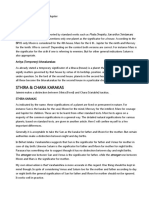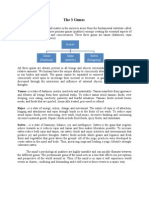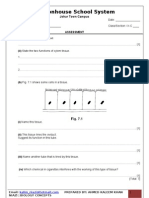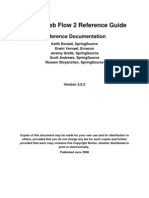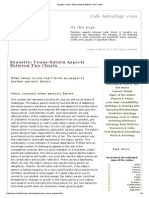Rules - For Planet Aspects
Rules - For Planet Aspects
Uploaded by
santhuuskumarCopyright:
Available Formats
Rules - For Planet Aspects
Rules - For Planet Aspects
Uploaded by
santhuuskumarOriginal Title
Copyright
Available Formats
Share this document
Did you find this document useful?
Is this content inappropriate?
Copyright:
Available Formats
Rules - For Planet Aspects
Rules - For Planet Aspects
Uploaded by
santhuuskumarCopyright:
Available Formats
Reviving The Rules For Drishti By Gauranga Das Maharishi Parasara elaborately describes the rules for Dristi
or aspects, which play a very important role in assessing the results of different houses, planets and Lagnas. He is describing three categories of aspects in chapters 9 and 28 o f Brihat Parasara Hora Sastra, still the majority of Jyotishas nowadays seem to be unfamiliar with the calculation and usage of these aspects. The three categor ies of aspects are Rasi Dristi (sign aspects), Graha Dristi (planetary aspects) and Sphuta Dristi (aspects by degree), which is actually the subtle form of Grah a Dristi. These three have specific methods of calculation and find different us e according to their nature in Rasi and divisional charts. First let us define, what the term Dristi or aspect means! The original Sanskrit term Drishti means glance. The planets and the houses represent animate and inani mate objects respectively in the natives chart. Both may cast their glances to ce rtain other places in the chart and thereby extend their influences there. Of co urse the Dristi of a planet, even if very strong, will not cause such influence as the occupation of the same sign by the planet, still it has considerable effe cts in many cases. In the following sections I will explain the rules for the th ree types of Dristi. Rasi Dristi Rasi Dristi means the aspect of signs. The rules for this aspect are as follows: 1. All cardinal signs (Chara Rasis) aspect the three fixed signs for the excepti on of the one adjoining them. 2. Similarly, all fixed signs (Sthira Rasis) aspect the three cardinal signs for the exception of the one adjoining them. 3. And all dual signs (Dwisvabhava Rasis) aspect all the three other dual signs for the exception of themselves. For example Aries aspects Leo, Scorpio and Aquarius, but not Taurus. Taurus aspe cts Cancer, Libra and Capricorn, but not Aries. Gemini aspects Virgo, Sagittariu s and Pisces. 4. The planets in these signs aspect the same signs by Rasi Dristi. 5. Aspects may be casted by empty signs and on empty signs as well. 6. All aspects between two signs are mutual and full. The above rules are suggestive of two things: Firstly, by stating them it is imp lied that Maharishi Parasara supported the sign=house division system, as oppose d to the other two, equal house and Sripati house division systems, as Rasi Dris ti will have meaning only if we equal the signs to the houses. Secondly, this ki nd of aspect is not dependent on the degree positions of the planets in the sign s, hence can be extended to the divisional charts which thus can be studied as s eparate charts in themselves. What is the reason for the movable and fixed signs aspecting each other but the dual signs aspecting only themselves? The movable signs are lorded by Brahma, an d represent the creative force, the Raja Guna. The fixed signs are lorded by Shi va, and represent the destructive force, the Tama Guna. Krishna says in the Bhag avad-gita: jaatasya hi dhruvo mrityur dhruvam janma mritasya ca, meaning that fo r the one who is born, death is sure and for one who dies rebirth is sure.
Therefore the aspect of movable and fixed signs on each other represents the sam sara, or repetition of birth and death during the process of reincarnation. But Krishna also says that na jaayate mriyate vaa kadaacin, i.e. the soul is never b orn nor will ever cease to exist. We may realize our eternal spiritual existence when we come under the Sattwa Guna, or mode of goodness, which is ruled by Sri Vishnu, and is represented by the dual signs. Thus the dual signs aspect only ea ch other, as the soul never really mixes with matter. Graha Dristi The second type of aspects is called Graha Dristi, and it is casted by the plane ts in the chart, upon certain houses counted forward from them. In Graha Dristi calculations the Maharishi again refers to the signs as houses and states that t he given planet aspects the full house in question irrespective of the degrees o ccupied by him in his Rasi. The Graha Dristi is not always full, but can be with one foot (25%), two feet (50%), three feet (75%) and finally four feet (100%). He also lists separate rules for the aspects cast by Jupiter, Mars and Saturn as follows: 1. Saturn aspects the 9. and 5. house with one foot, the 4. and 8. house with tw o feet, the 7. house with three feet, and the 3. and 10. house with four feet. 2. Jupiter aspects the 4. and 8. house with one foot, the 7. house with two feet , the 3. and 10. house with three feet, and the 5. and 9. house with four feet. 3. Mars aspects the 7. house with one foot, the 3. and 10. house with two feet, the 9. and 5. houses with three feet, and the 4. and 8. houses with four feet. 4. The other planets (Sun, Moon, Mercury and Venus) aspect the 3. and 10. house with one foot, the 5. and 9. house with two feet, the 4. and 8. house with three feet, and the 7. house with four feet. We have seen in the above that all plane ts cast Graha Dristi on the 3., 4., 5., 7., 8., 9. and 10. houses from their positions. None of them aspect the 2., 6., 11. and 12. houses. Why is that? The planets cannot glance to the houses neighbourin g them (2. and 12. house) as they are too close to them. These houses however ma y influence the house through Argala (caused by the 2 nd ) and Virodhargala (obs truction to Argala caused by the 12 th ), or Subha- and Paapakartari yogas (occu pation of 2. and 12 th by only benefic or only malefic planets which influence t he house ina positive or negative way). Bandhana yoga is also caused by equal number of planets on either side of a sign. The 6. and 11. (6. from 6.) houses s ignify enemies and friends (enemies of enemies), which are both controlled by Go d. There is a Bengali saying: Rakhe Krishna Mare Ke, Mare Krishna Rakhe Ke, meaning that if Krishna wants to p rotect you, who will be ale to kill you, and if Krishna wants to kill you, who w ill be able to protect you? Now we may put the question: Why do Jupiter, Mars and Saturn have special aspect s and why on the given houses? Firstly, only these are the three planets that ar e outside the Suns orbit, so the rest of the planets will be able to cast their a spects only as the Sun does. Now lets see the reason for each planet to cast full aspects on certain houses. Mars has full Dristi on the 4. and 8. house form himself. The son of Mars is cal led Mrityu, and he is rising at the beginning of the portion of the day (or nigh t) ruled by Mars (see BPHS 3.69.) Mrityu means death, and Mars tends to cause da nger to life or unnatural death. Thus the houses ruling life and longevity are a spected by him. The 8 th house signifies longevity, while the 4 th house indicat es the heart, which holds the conscious soul, which leaves the body at the time of death as the heart also stops beating.
Jupiter casts full aspect on the 5. and 9. house, which direct pious activities of previous life (poorva-punya) and religiousness (dharma) or fortune (bhagya) r espectively. Jupiter, being Brihaspati, the teacher of the demigods, is the give r of these things. Saturn casts full aspect on the 3. and 10. house, because the y are Upachayas, the houses of growth. Saturn is eunuch and is very old, so he i s devoid of the ability to grow, therefore he always desire so. He cannot influe nce the 6 th and 11 th houses, which are also Upachayas, because they are contro lled by God, as we have stated before. As for the aspects of Rahu and Ketu, they are the head and the body of the demon Rahu respectively. Rahu wanted to take the position of the demigods and drink t he nectar of immortality, but Vishnu in the form of Mohini Murti severed his hea d from his body. Therefore Rahu has the similar aspects to Jupiter, the Guru of demigods, as he has the desire to spoil what Jupiter gives. So the aspect of Jup iter on the 5 th and 9 th houses indicates poorva-punya while the aspect of Rahu on the same indicates poorva-paapa, or sinful activities in previous birth. Rahu also has an aspect on the 2 nd house from his position, which is actually t he 12 th , as Rahu is retrograde. The 12 th house indicates the dharma inherited from our gotra, or dynasty, which Rahu did not want to follow. He was born in t he dynasty of Asuras (demons), but he wanted to be in the positions of Suras (de migods). Ketu, on the other hand, being the severed body of Rahu does not have a head and eyes, hece he cannot glance. He will not be able to cast any Graha Dristi, only Rasi Dristi. Of course, there would be a malefic influence on the 3., 6. and 11. houses from Ketu, but this is actually caused by Rahu, which is always opposite Ketu. Usually while judging Graha Dristi, only the full aspects are taken into conside ration, and from the above it is evident that mutual full Graha Dristi is relati vely rare between two planets. Sphuta Dristi We have seen in the above that Graha Dristi may be full or of 1/4, 1/2 or 3/4 st rength. But in the 28 th chapter of BPHS Maharishi Parasara also describes furth er rules to determine the strength of the aspect in a more subtle way depending on the angular distance between the aspecting planet and the aspected body, whic h as in Graha Dristi may be another planet, a house cusp or one of the Lagnas as well. The values of sphuta Dristi may be one Rupa, or full aspect or less than that. The aspectual values which are less than one Rupa are usually expressed in Virupas or Kalas, where 1 Rupa=60 Virupa. The first step is to find the angular distance counting from the aspecting planet forwards zodiac ally to the aspected body. The exact degrees of both should be known for this. L ets call this difference D. Obviously D will always be between 0 and 360 If D<30 or D>300, then the Sphuta Dristi is always zero. For the rest of the values there ar e different rules of calculation depending on the value of D as follows (S means the value of Srhuta Dristi expressed in Virupas): 1. 2. 3. 4. 5. 6. If If If If If If 30<D<60, then S=(D/2-15 60<D<90, then S=D-45 90<D<120, then S=90-D/2 120<D<150, then S=150-D 150<D<180, then S=2D-300 180<D<300, then S=150-D/2
The above rules are valid for Sun, Moon, Mercury and Venus. Here again we will h ave special rules for the outer planets. Rules for Saturn aspecting:
1. 2. 3. 4. 5. 6. 7. 8.
If If If If If If If If
30<D<60, then S=2D-60 60<D<90, then S=120-D 90<D<120, then S=90-D/2 120<D<150, then S=150-D 150<D<180, then S=2D-300 180<D<240, then S=150-D/2 240<D<270, then S=D-210 270<D<300, then S=600-2D
Rules for Mars: 1. 2. 3. 4. 5. 6. 7. 8. If If If If If If If If 30<D<60, then S=D/2-15 60<D<90, then S=D+D/2-75 90<D<150, then S=150-D 150<D<180, then S=2D-300 D=180, then S=60 180<D<210, then S=150-D/2 210<D<240, then S=270-D 180<D<300, then S=(150-D/2
Rules for Jupiter: 1. 2. 3. 4. 5. 6. 7. 8. 9. If If If If If If If If If 30<D<60, then S=D/2-15 60<D<90, then S=D-45 90<D<120, then S=D/2 120<D<150, then S=180-D 150<D<180, then S=2D-300 180<D<210, then S=150-D/2 210<D<240, then S=D-150 240<D<270, then S=300-D 180<D<300, then S=150-D/2
So as we have seen, it is very cumbersome to calculate the Sphuta Dristi of all the planets on all the house cusps, other planets and special ascendants. Theref ore in practical readings Rasi and Graha Dristi is used mostly. Of course the us age of Sphuta Dristi for fine-tuning the strength of the aspect is not prohibite d. How to use Dristis? Maharishi Parasara recommends taking into consideration both Rasi and Graha Dris tis for judging the results of the horoscope. But he gives pre-eminence to Rasi Dristi, as this is always full and mutual aspect, and it will indicate the real influences on the given house, which will manifest in reality. On the other hand , he sole planetary aspect on a sign may indicate the desire, which may or may n ot be fulfilled. For example if there are only planetary aspects on someones 5 th house, but no Rasi Dristi, then he may be very desirous of having children, but may still not have them. The other point of consideration is that Rai Dristi may be easily applied in all the divisional charts, while it is impossible to apply Sphuta Dristi, and the applicability of Graha Dristi in divisional charts is hi ghly disputable. Lets see an example for using Rasi and Graha Dristi in Rasi chart, and Rasi Drist i in Navamsha chart. Bill Clinton was born on 19 th August 1946 at 3.47 am 6 hrs + GMT, in Hope (33N40 93W36). His Lagna is in Cancer, and Moon, the lord of Lagna is in Aries in the 10th hous e. Moon is also Atmakaraka, thereby becoming a very important planet for the native . The 10th house is the house of career, and gives military or political occupat
ion. Lagna is occupied by Mercury (communication) and Saturn (administration), a nd the Rasi Dristi of naturally exalted Rahu and Ketu also strengthens the other wise not very charismatic sign Cancer. Venus and Mars aspect the Ghati Lagna and Hora Lagna, increasing influence and wealth. But they are not strongly connecte d to the Lagna, so much of that wealth and power goes to his associates represen ted by the 3rd house. But Mercury as lord of Hora Lagna in Lagna gives personal power as well. The Moon and Jupiter have only Graha Dristi, but their dispositor s conjoin. They also form a Gajakesari yoga which gives success. Sun in the 2nd in won house gives good wealth coming from p olitical sources, and it also has mutual aspects with Jupiter, which is in Arudh a Lagna, thus giving good fame. Rahu casts a Rasi Dristi on the Arudha Lagna, th us causing ill fame in connection with his position as a husband. Mars has got Graha Dristi on the 10th house, thereby indicating the support of p owerful allies. But the 3rd house also has the Graha Dristi of Saturn and Rahu, thus some of these allies may help out of self-interest. Navamsha Lagna also has got aspect from Venus in the 10th from it, and Venus bei ng the lord of Ghati Lagna indicates great inlfuence and power. Jupiter is Vargo ttama in Libra, and aspects the Arudha Lagna. Lord of Lagna conjuncts debilitate d Moon in Scorpio, but again the aspect of Mars from won house and exalted Sun m akes the Karakamsha strong, and gives political influence to the native. Mars and Sun being in the Arudha of 10th house also aspect Rahu and Ketu , making him able to overpower all obstacles and enemies.
You might also like
- Sasthamkotta - KP Horary Software - Prashna Kundali Software - Free KP Astrology SoftwareDocument3 pagesSasthamkotta - KP Horary Software - Prashna Kundali Software - Free KP Astrology SoftwareBad BrothersNo ratings yet
- The Strange Result of Debl Merc, Sat in EngDocument23 pagesThe Strange Result of Debl Merc, Sat in Engag140291No ratings yet
- Lab 7. ConsolidationDocument8 pagesLab 7. ConsolidationInam UllahNo ratings yet
- Pukka GhaDocument3 pagesPukka GhaMrityunjaya AroraNo ratings yet
- With The Use of Examples Discuss The Extent To Which You Agree With This StatementDocument3 pagesWith The Use of Examples Discuss The Extent To Which You Agree With This Statementbrennan1234589% (9)
- Dhristi SidhantaDocument4 pagesDhristi SidhantaDiego VazquezNo ratings yet
- Astrology For Layman: The most comprehensible book to learn astrologyFrom EverandAstrology For Layman: The most comprehensible book to learn astrologyRating: 1 out of 5 stars1/5 (1)
- Effects of House lord in 27 Nakshatras: Vedic AstrologyFrom EverandEffects of House lord in 27 Nakshatras: Vedic AstrologyRating: 5 out of 5 stars5/5 (1)
- Jupiter Transits: Astrology/Jyotish, #2From EverandJupiter Transits: Astrology/Jyotish, #2Rating: 3.5 out of 5 stars3.5/5 (4)
- Decoding Indian Calendar: Alka Parikh & Aayush RavalDocument8 pagesDecoding Indian Calendar: Alka Parikh & Aayush RavalTJPRC PublicationsNo ratings yet
- ParyayasDocument3 pagesParyayasRohit SahuNo ratings yet
- The Use of The 64TH Navamsa in Predictive Astrology C S Patel A Case Study PDFDocument3 pagesThe Use of The 64TH Navamsa in Predictive Astrology C S Patel A Case Study PDFSanil KumarNo ratings yet
- TFU MasterClass KP Astrology RuleBookDocument8 pagesTFU MasterClass KP Astrology RuleBookrishab2709005100% (1)
- Alternate or Special LagnasDocument6 pagesAlternate or Special LagnasGanapathi Nayak KNo ratings yet
- Sthira & Chara Karakas: Phala Deepika, Sarvartha Chintamani, Jataka ParijataDocument2 pagesSthira & Chara Karakas: Phala Deepika, Sarvartha Chintamani, Jataka ParijataVivek ChauhanNo ratings yet
- Explains ParyayasDocument3 pagesExplains ParyayasRohit SahuNo ratings yet
- 5) Delineation & Dynamic Configuration: TopicsDocument15 pages5) Delineation & Dynamic Configuration: TopicsmatriNo ratings yet
- Divisional ConsiderationsDocument5 pagesDivisional ConsiderationsHoracio TackanooNo ratings yet
- Definition of A GrahaDocument7 pagesDefinition of A GrahaSuperlativeIndiaNo ratings yet
- Jaimini Astrology - Chara DashaDocument5 pagesJaimini Astrology - Chara DashaVijay DuaNo ratings yet
- The 3 GunasDocument2 pagesThe 3 Gunasnirali_289No ratings yet
- Dasha CalculatorDocument6 pagesDasha CalculatorKALSHUBHNo ratings yet
- Neeraj Sobti-VarshaphalaDocument5 pagesNeeraj Sobti-VarshaphalaAvanindra MisraNo ratings yet
- Relationship Between Nakshatra Pada and NavamsaDocument1 pageRelationship Between Nakshatra Pada and NavamsaastrologernatashasagarNo ratings yet
- Divisional Charts SignificationDocument2 pagesDivisional Charts SignificationPratik PatelNo ratings yet
- By Prof Sharad C Joshi, India: Late Shri Jivanrao T ChitnisDocument5 pagesBy Prof Sharad C Joshi, India: Late Shri Jivanrao T Chitnisadya_tripathiNo ratings yet
- Tragic Accident of Mr. Michael SchumacherDocument5 pagesTragic Accident of Mr. Michael SchumacherSastry KarraNo ratings yet
- 101 ObservationsoftheEffectsoftheMoonsNodesonthePersonalityDocument4 pages101 ObservationsoftheEffectsoftheMoonsNodesonthePersonalitySachin MathurNo ratings yet
- 25 BirthTimeRectificationAnInnovativeApproachDocument17 pages25 BirthTimeRectificationAnInnovativeApproachJessica Johnson100% (1)
- Bhrigu AstrologyDocument5 pagesBhrigu Astrologyज्योतिष आचार्याNo ratings yet
- TenantDocument3 pagesTenantZaw Htut100% (1)
- Planetary CampsDocument1 pagePlanetary CampsSunil RupaniNo ratings yet
- Cast Your HoroscopeDocument27 pagesCast Your HoroscopeSunil ShastriNo ratings yet
- VedicReport 1592842190010 PDFDocument100 pagesVedicReport 1592842190010 PDFDanny AtaideNo ratings yet
- D30 OverviewDocument1 pageD30 OverviewRavin Taira PalNo ratings yet
- Jyotish - AIFAS - Prediction Through Dasha & YoginiDocument11 pagesJyotish - AIFAS - Prediction Through Dasha & YoginiHpone NyuntNo ratings yet
- AstroWeb ShadBala & BhavBala TablesDocument3 pagesAstroWeb ShadBala & BhavBala Tablesnmsusarla999No ratings yet
- Principles of Kundli AnalysisDocument11 pagesPrinciples of Kundli AnalysisDharmesh100% (1)
- Pilgrimage - RemedyDocument2 pagesPilgrimage - RemedyHemant BhattNo ratings yet
- RashiDocument14 pagesRashiajay khandelwalNo ratings yet
- Mars Retrogression & Triple TransitDocument2 pagesMars Retrogression & Triple TransitsnmurthypNo ratings yet
- Koota Matching System V6Document2 pagesKoota Matching System V6madhurithaNo ratings yet
- Sreeastropont - Blogspot.in-Basics of Jaimini AstrologyDocument2 pagesSreeastropont - Blogspot.in-Basics of Jaimini AstrologysubramanyaNo ratings yet
- 07 Chapter 1Document69 pages07 Chapter 1KirtiMishraNo ratings yet
- Vedic Astrology - Love Marriages - sARABJIT pODDARDocument4 pagesVedic Astrology - Love Marriages - sARABJIT pODDARGogo198No ratings yet
- Sutras of NadiDocument20 pagesSutras of NadiMoNo ratings yet
- AshtakaVarga Audio LessonDocument4 pagesAshtakaVarga Audio Lessonnabin shresthaNo ratings yet
- KPDocument292 pagesKPexpertjatakNo ratings yet
- Astakvarga - Concept and ApplicationDocument2 pagesAstakvarga - Concept and ApplicationkedeejoshiNo ratings yet
- KPP Astrology2Document42 pagesKPP Astrology2Manoj Singh ChouhanNo ratings yet
- Dasa and Remedies From ParasharaDocument11 pagesDasa and Remedies From ParasharaSandeep ArkalgudNo ratings yet
- How To Calculate AgeDocument7 pagesHow To Calculate AgeVicaas VS100% (2)
- Vimshottari Dasha (Mahadasha) : Aashish AroraDocument2 pagesVimshottari Dasha (Mahadasha) : Aashish AroraRajeshraj SharmaNo ratings yet
- Ruling PlanetsDocument2 pagesRuling PlanetsArunKumarNo ratings yet
- Venus Progression 27 MonthsDocument1 pageVenus Progression 27 MonthskbludosNo ratings yet
- Aparnita HM2Document10 pagesAparnita HM2Pratul VisheraNo ratings yet
- DefinitionDocument3 pagesDefinitionJyothi VadhirajNo ratings yet
- Vedic Astrology Remedies For Hurdles in Professional SuccesDocument38 pagesVedic Astrology Remedies For Hurdles in Professional Succesimabhinav19738No ratings yet
- Jamakol ArudamDocument1 pageJamakol Arudamsrinath purushothamNo ratings yet
- When Can I Buy A Vehicle and When Can I Sell ItDocument8 pagesWhen Can I Buy A Vehicle and When Can I Sell ItsrikarbNo ratings yet
- 0610 Nov 02 QP 2 Cells, Tissue)Document2 pages0610 Nov 02 QP 2 Cells, Tissue)Ahmed Kaleem Khan Niazi100% (1)
- Presentation To The Motor Vehicle Working Group (MVWG)Document12 pagesPresentation To The Motor Vehicle Working Group (MVWG)American Import Agents AssociationNo ratings yet
- Amt in A Nutshell - ExplainedDocument2 pagesAmt in A Nutshell - ExplainedMis El100% (2)
- Elements of The Socratic Method - I - Systematic QuestioningDocument8 pagesElements of The Socratic Method - I - Systematic Questioningdrleonunes100% (4)
- -Voltage 伏特 - Coulomb 庫倫 - Ampere 安培Document19 pages-Voltage 伏特 - Coulomb 庫倫 - Ampere 安培noybitNo ratings yet
- Great Place To WorkDocument25 pagesGreat Place To Workatul_uttam1No ratings yet
- Academic Account Manager Business Development in Philadelphia PA Resume Scott BardDocument2 pagesAcademic Account Manager Business Development in Philadelphia PA Resume Scott BardScottBardNo ratings yet
- Wazwaz IEch 3 S 2 S 5 P 4Document1 pageWazwaz IEch 3 S 2 S 5 P 4ShaMIiii JuTTNo ratings yet
- PositionDocument9 pagesPositionkristelle ducayNo ratings yet
- Charter of ActivitiesDocument3 pagesCharter of ActivitiesAldrin M. ObiasNo ratings yet
- The Factors That Affect Students DecisioDocument10 pagesThe Factors That Affect Students DecisioJillian LaluanNo ratings yet
- Chidi Maduka - Full Paper 61Document22 pagesChidi Maduka - Full Paper 61Stephanie Lee100% (1)
- Spring Webflow ReferenceDocument92 pagesSpring Webflow Referencemenna_moustafaNo ratings yet
- LXI H, 4050H MOV A, M INX H ADD M INX H MOV M, A JNC Loop INX H MVI M, 01H Loop: HLTDocument7 pagesLXI H, 4050H MOV A, M INX H ADD M INX H MOV M, A JNC Loop INX H MVI M, 01H Loop: HLTNaga Rajesh ANo ratings yet
- Numerical Simulation of Emulsion Flow Through Porous Media M.R. Islam S.M. Farouq AliDocument12 pagesNumerical Simulation of Emulsion Flow Through Porous Media M.R. Islam S.M. Farouq Alilulalala8888No ratings yet
- A Complex Mixture of ForcesDocument19 pagesA Complex Mixture of ForcesdrguillermomedinaNo ratings yet
- 2&3 - Project Management Frame WorkDocument47 pages2&3 - Project Management Frame WorkFeras Mohammed SiddigNo ratings yet
- Uniform Code of Ethics Business and It Professional EthicsDocument4 pagesUniform Code of Ethics Business and It Professional EthicsMuhammad Haris GinanjarNo ratings yet
- .No. Standard Description Reaffirmed No. of Amd. View Imagenumber of Standards - 11Document1 page.No. Standard Description Reaffirmed No. of Amd. View Imagenumber of Standards - 11gaurav522chdNo ratings yet
- Synastry - Venus-Saturn Aspects Between Two ChartsDocument4 pagesSynastry - Venus-Saturn Aspects Between Two ChartsAndrea GasparNo ratings yet
- The Role of TrustDocument26 pagesThe Role of TrustWoody WongNo ratings yet
- Chapter 1 IntroductionDocument3 pagesChapter 1 IntroductionAnkur VermaNo ratings yet
- Lauragrueneberg ResumeDocument2 pagesLauragrueneberg Resumeapi-746328092No ratings yet
- 03 Truncation ErrorsDocument37 pages03 Truncation ErrorsArturo Avila100% (1)
- B. A. Remington Et Al - Supernova Hydrodynamics Experiments On The Nova LaserDocument10 pagesB. A. Remington Et Al - Supernova Hydrodynamics Experiments On The Nova LaserTuoma2No ratings yet
- Torchshield Primer TdsDocument2 pagesTorchshield Primer Tdspandey71087No ratings yet
- Core CoursesDocument3 pagesCore CoursesSammy EliasNo ratings yet
- Punk ArchaeologyDocument234 pagesPunk Archaeologybillcaraher100% (4)
















